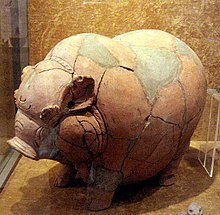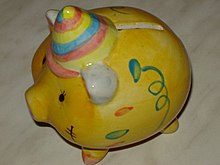Piggy bank: Difference between revisions
No edit summary |
Undid revision 260391262 by 70.144.18.3 (talk) |
||
| Line 7: | Line 7: | ||
'''Piggy bank''' (sometimes '''penny bank''' or '''money box''') is the traditional name of a [[coin]] accumulation and storage container; it is most often, but not exclusively, used by [[child]]ren. The piggy bank is known to collectors as a "[[still bank]]" as opposed to the "[[mechanical bank]]s" popular in the early 20th century. These items are also often used by corporations for promotional purposes. |
'''Piggy bank''' (sometimes '''penny bank''' or '''money box''') is the traditional name of a [[coin]] accumulation and storage container; it is most often, but not exclusively, used by [[child]]ren. The piggy bank is known to collectors as a "[[still bank]]" as opposed to the "[[mechanical bank]]s" popular in the early 20th century. These items are also often used by corporations for promotional purposes. |
||
Piggy banks are typically made of [[ceramic]] or [[porcelain]], and serve as a pedagogical device to teach the rudiments of thrift and savings to children; money can be easily inserted, but in the traditional type of bank the pig must be broken open for it to be retrieved. Most modern piggy banks, however, have a rubber [[plug]] located on the underside |
Piggy banks are typically made of [[ceramic]] or [[porcelain]], and serve as a pedagogical device to teach the rudiments of thrift and savings to children; money can be easily inserted, but in the traditional type of bank the pig must be broken open for it to be retrieved. Most modern piggy banks, however, have a rubber [[plug]] located on the underside; others are made of vinyl and have a removable nose for easy coin access. Some piggy banks incorporate [[Electronics|electronic]] systems which calculate the amount of money deposited. <ref>{{cite web|url=http://gizmodo.com/gadgets/gadgets/digibank-piggy-and-panda-banks-learn-to-count-239597.php|title=DigiBank Piggy and Panda Banks Learn to Count|publisher=Gizmodo|accessdate=2008-11-09}}</ref> |
||
==Etymology== |
==Etymology== |
||
Revision as of 22:40, 27 December 2008



Piggy bank (sometimes penny bank or money box) is the traditional name of a coin accumulation and storage container; it is most often, but not exclusively, used by children. The piggy bank is known to collectors as a "still bank" as opposed to the "mechanical banks" popular in the early 20th century. These items are also often used by corporations for promotional purposes.
Piggy banks are typically made of ceramic or porcelain, and serve as a pedagogical device to teach the rudiments of thrift and savings to children; money can be easily inserted, but in the traditional type of bank the pig must be broken open for it to be retrieved. Most modern piggy banks, however, have a rubber plug located on the underside; others are made of vinyl and have a removable nose for easy coin access. Some piggy banks incorporate electronic systems which calculate the amount of money deposited. [1]
Etymology
In Middle English, "pygg" referred to a type of clay used for making various household objects such as jars. People often saved money in kitchen pots and jars made of pygg, called "pygg jars". By the 18th century, the spelling of "pygg" had changed and the term "pygg jar" had evolved to "pig bank." [2]
Once the meaning had transferred from the substance to the shape, piggy banks began to be made from other substances, including glass, plaster, and plastic.
In a curious case of parallel evolution, the Indonesian term celengan (a celeng is a wild boar, with the "an" affix used to denote a likeness) was also used in the context of domestic banks. The etymology of the word is obscure, but evident in a Majapahit piggy bank from the 15 century A.D.
Uses
The general use of piggy banks is to store loose change in a quaint, decorative manner. These containers may serve other uses, such as functioning as swear jars or a hiding places for domestic contraband such as cigarettes, drugs or condoms. Modern piggy banks are not limited to the likeness of pigs, and may come in a range of animal shapes, sizes and colours. Many times a family could empty spare change into one and then split the coins when the bank is full. Many people collect piggy banks as a hobby.
Famous

Rachel, the official mascot of Pike Place Market in Seattle, Washington, is a bronze cast piggy bank that weighs nearly 600 pounds, located at the corner of Pike Place under the "Public Market Center" sign. Rachel was designed by local artist Georgia Gerber and modeled after a pig (also named Rachel) that lived on Whidbey Island and was the 1977 Island County prize-winner. Rachel receives roughly $9,000USD annually in just about every type of world currency, which is collected by the Market Foundation to fund the Market's social services. Locals make a habit of emptying their pockets and rubbing Rachel's snout for good luck.
References
- ^ "DigiBank Piggy and Panda Banks Learn to Count". Gizmodo. Retrieved 2008-11-09.
- ^ "What's the origin of the piggy bank?". The Striaght Dope. Retrieved 2008-10-17.
External links
- What's the origin of the piggy bank? (from The Straight Dope)
- The Piggy Bank page Photographs and Facts about Piggy Banks
- Piggy Bank Project Hundreds of Piggy Characters and customised ceramic Piggy Banks
